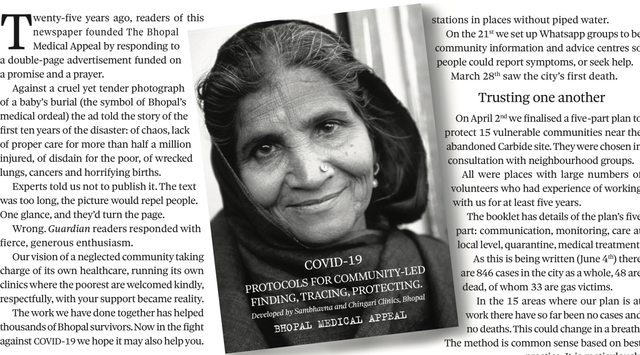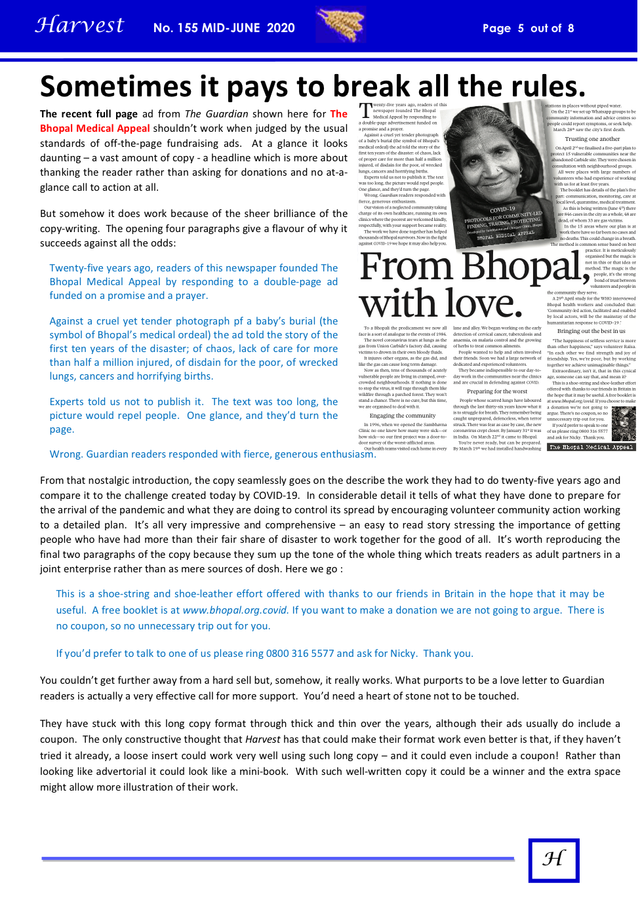Bhopal Medical Appeal: At a time of crisis, Bhopal’s clinics give back something beyond price
- Exhibited by
- Ken Burnett
- Added
- July 02, 2020
- Medium of Communication
- Newspaper advertisements
- Target Audience
- Type of Charity
- Health
- Country of Origin
- UK
- Date of first appearance
- 2020
SOFII’s view
This is an extraordinary advertisement. As usual with Bhopal Medical Appeal (BMA) press ads, its style breaks most of the established rules for ‘off-the-page’ advertising. It’s a long emotional story told from the heart, with absolute sincerity. No artifice or advertising techniques here, just an extraordinary reversal of the traditional donor / cause paradigm. Here Bhopal’s clinics Sambhavna and Chingari are giving back to Guardian readers who 25 years earlier had given so generously to set up these life-saving clinics to help the stricken people of Bhopal. Under the threat of pandemic, now the people of Britain themselves need help. And Bhopal’s clinics are uniquely placed to contribute their experience, expertise and love. So they give it, freely, by providing an action plan that can be adapted by communities everywhere to protect themselves against coronavirus.
We don’t have the full results yet, but we do know that just a few days after its appearance the first ad was not only delivering copies of a useful booklet it was covering its costs and looking set to return a reasonable net income. Not a bad initial result for such a uniquely generous offer from Indian health workers accompanied only incidentally with such a sensitive, almost imperceptible ask. Oh how we might wish that Britain had prepared for the onset of the pandemic as thoughtfully, as expertly and in as co-ordinated a manner as did the people of Bhopal.
‘You couldn’t get further away from a hard sell but, somehow, it really works. What purports to be a love letter to Guardian readers is actually a very effective call for more support. You’d need a heart of stone not to be touched.’
The real benefits of these ads will, SOFII suspects, reveal themselves over time. The analysis from Andrew Papworth in the June edition of Harvest is delightfully perceptive and revealing, so we are reproducing it in its entirety, opposite.
Creator / originator
Art directed by Neil Godfrey, written by Indra Sinha and Kat Pilkington. Published boldly by the Bhopal Medical Appeal, executive trustee Tim Edwards.
Background
The Bhopal Medical Appeal was started by press advertising, all of its quirky, stunning and hugely effective ads created by one of the true greats of UK advertising and fundraising, Indra Sinha (see Wikipedia, here). BMA already has a series of massively successful press advertisements to its credit, proudly shared on SOFII here. These two advertisements are fitting additions to the archive of an all-time fundraising great.
Special characteristics
The ads opposite reflect a deliberate departure from a long and honourable tradition for BMA. Here, the clinics are giving, not asking. There is no coupon – with coronavirus having overwhelmed daily life for people everywhere, the Team didn’t want to ask donors to risk going outside to find a post-box. There may have been a price paid for this in reduced direct response but in the spirit of the ad, the decision was both bold and right.
Influence / impact
For Guardian readers who remember those earlier ads the impact must have been very considerable. The full benefits from these ads will no doubt unfold over time. Hopefully a legacy or two might have been influenced, who knows? The gift was given with love, with no certainty or expectation of return.
A longer version of the ad is also scheduled to appear in The Daily Telegraph newspaper, the difference being solely to accommodate the larger page size of the still broadsheet Telegraph. A copy of that advertisement is also included here. We will add details of the response to both ads, when we can.
Other relevant information
When Indra and I were discussing these ads prior to their publication he told me of some of the hoops they’d had to jump through to get permission from the papers to run the copy as they’d wanted. This of course against the background of declining readership of print media, particularly at this time of pandemic and lockdown. ‘It seems,’ Indra said, ‘that printed news is in its death throes.’
We’ve heard it before and of course Indra may be right, but we all hope not, I’m sure. For as Indra Sinha has shown more effectively than anyone, through this and similar campaigns the printed news has delivered much good in this world and has the capacity, as these recent ads show, to keep on doing it. If future would-be aficionados of fundraising ‘off-the-page’ are prepared to learn from established masters such as Indra Sinha, fundraising will thrive and that too might help to keep the printed page going a while longer. Inspired by Indra and his likes we can craft the stories that will change the world, but we need the right delivery mechanisms to get our messages to the right readers at the right time, in the right way.
That night…
December 3rd, 1984. Shortly after midnight, 27 tonnes of a gas 500 times more deadly than cyanide leaked from Union Carbide’s factory in Bhopal, India. There was no warning, none of the plant's safety systems were working. In the city people were sleeping. They woke in darkness to the sound of screaming, with gas already in their eyes, noses and mouths. They began retching and coughing up froth streaked with blood. Whole neighbourhoods fled in panic, some were trampled, others convulsed and fell dead. People lost control of their bowels and bladders as they ran. Within hours thousands of dead bodies lay in the streets.
More than 25 years later, upwards of 100,000 people are still seriously ill. The drinking water of a further 20,000 has been poisoned by chemicals leaking from the abandoned plant. Ignoring ‘polluter pays’ laws, Union Carbide and its owner Dow Chemical have refused to pay for a clean-up.
IMAGES: ©Bhopal Medical Appeal
Also in Categories
-




















